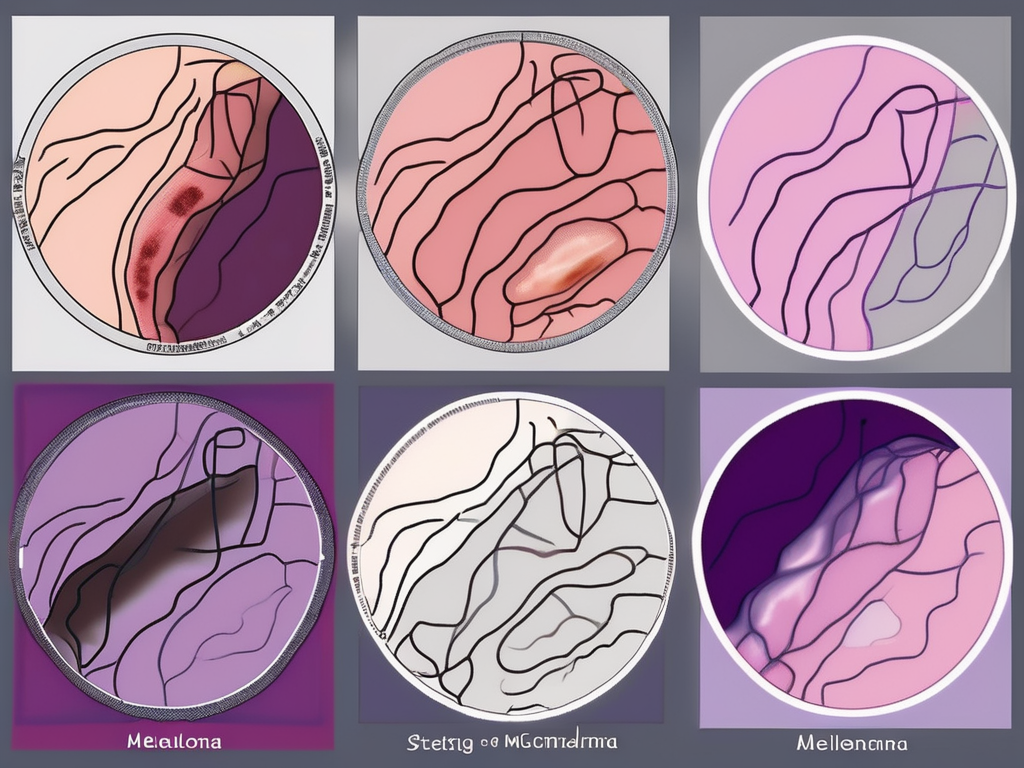This insightful article provides an in-depth look at melanoma, a serious form of skin cancer arising from melanocytes. Highlighting the critical importance of early detection, it explores the risk factors, early warning signs following the ABCDE rule, and the differentiation between benign and malignant lesions. It discusses melanoma’s various subtypes, such as superficial spreading melanoma and nodular melanoma, emphasizing the unique clinical features of each. The piece delves into the significance of staging and classification in tailoring treatment plans and outlines the genetic factors contributing to melanoma susceptibility, suggesting genetic counseling for those at increased risk. Special attention is given to melanoma in children and older adults, underscoring the necessity for tailored diagnostic criteria and regular skin examinations. For managing suspicious lesions, the guidance encourages consulting healthcare professionals for accurate diagnosis and timely treatment. This comprehensive overview serves as a valuable resource for understanding melanoma’s complexities, advocating for proactive skin health management and the importance of professional guidance in detecting and treating this condition effectively.
Melanoma is a type of skin cancer that develops when the cells that give color to our skin, called melanocytes, start to grow abnormally. It is a serious condition that requires prompt attention and treatment. In this article, we will explore the clinical features and diagnosis of melanoma, helping you to understand the risk factors, identify early warning signs, differentiate between benign and malignant lesions, and learn about the staging and classification of melanoma. Additionally, we will delve into the role of genetics in melanoma development, discuss melanoma in special populations such as children and older adults, and provide guidance on the management of suspicious skin lesions.
Introduction to Melanoma
Melanoma is a form of skin cancer that originates in the melanocytes, which are cells responsible for producing melanin, the pigment that gives color to our skin, hair, and eyes. These specialized cells are found in the basal layer of the epidermis, the outermost layer of the skin. Melanoma is characterized by the uncontrolled growth of melanocytes, leading to the formation of malignant tumors.
Although melanoma can occur in any part of the body, it commonly develops on areas exposed to the sun, such as the face, neck, arms, and legs. This is because prolonged exposure to ultraviolet (UV) radiation from the sun or artificial sources, such as tanning beds, can damage the DNA in melanocytes, triggering mutations that promote their abnormal growth. Additionally, certain genetic factors can increase the risk of developing melanoma, including a family history of the disease or inheriting specific gene mutations.
Early detection is crucial in treating melanoma, as it can spread quickly to other parts of the body if left untreated. The first sign of melanoma is often a change in the appearance of an existing mole or the development of a new, unusual-looking growth on the skin. The ABCDE rule is a helpful guide to identify potential signs of melanoma:
- Asymmetry: One half of the mole or growth does not match the other half.
- Border: The edges of the mole or growth are irregular, blurred, or jagged.
- Color: The color of the mole or growth is not uniform and may include shades of brown, black, tan, red, white, or blue.
- Diameter: The size of the mole or growth is larger than 6 millimeters (about the size of a pencil eraser).
- Evolving: The mole or growth is changing in size, shape, or color over time.
If you notice any of these signs or have concerns about a particular mole or growth, it is important to consult a dermatologist for a professional evaluation. Dermatologists are trained to identify and diagnose melanoma through a thorough examination of the skin and, if necessary, perform a biopsy to confirm the presence of cancerous cells.
By understanding the risk factors associated with melanoma, you can take steps to reduce your likelihood of developing this condition. Protecting your skin from excessive sun exposure is crucial in preventing melanoma. This includes wearing protective clothing, such as wide-brimmed hats and long-sleeved shirts, using sunscreen with a high sun protection factor (SPF), seeking shade during peak sun hours, and avoiding tanning beds altogether.
Furthermore, regular self-examinations of the skin can help detect any changes or abnormalities early on. It is recommended to perform a full-body skin check once a month, paying close attention to moles, freckles, and other pigmented areas. If you notice any changes or have concerns, make sure to schedule an appointment with a dermatologist promptly.
In conclusion, melanoma is a serious form of skin cancer that requires early detection and prompt treatment. By understanding the risk factors, recognizing the signs of melanoma, and taking preventive measures, you can protect yourself from this potentially life-threatening condition. Remember, your skin is your body’s largest organ, and taking care of it is essential for your overall health and well-being.
Understanding the Risk Factors of Melanoma
There are several risk factors that can increase the likelihood of developing melanoma. One of the primary factors is prolonged exposure to ultraviolet (UV) radiation, either from the sun or artificial sources such as tanning beds. Fair-skinned individuals with freckles, light-colored hair, and blue or green eyes are also at higher risk. Additionally, a family history of melanoma, a personal history of skin cancer, and having numerous moles or atypical moles can contribute to the risk. By being aware of these risk factors, you can take proactive measures to protect your skin and seek early medical attention if necessary.
Identifying the Early Warning Signs of Melanoma
Early detection of melanoma greatly improves the chances of successful treatment. When checking your skin for potential signs of melanoma, use the ABCDE rule as a guide: A for asymmetry (one half of the mole looks different from the other), B for border irregularity (uneven edges), C for color variation (multiple colors within the mole), D for diameter (larger than a pencil eraser), and E for evolving (changes in size, shape, or color over time). If you notice any of these warning signs or experience itching, bleeding, or pain in a mole or skin lesion, it’s essential to consult a healthcare professional for further evaluation.
Melanoma Subtypes and Associated Features
Melanoma can manifest in various subtypes, each with distinct clinical features. One subtype of melanoma is called superficial spreading melanoma, which typically starts as a flat, spreading lesion with irregular borders. Another subtype, nodular melanoma, presents as a raised, firm bump that grows rapidly. Lentigo maligna melanoma generally occurs in older individuals, often appearing as a slowly growing flat patch with varied colors. Acral lentiginous melanoma affects the palms of the hands, soles of the feet, or under the nails, showing as dark-colored streaks or patches. By recognizing these subtypes and their associated features, you can better understand and identify melanoma.
Differentiating between Benign and Malignant Skin Lesions
Not all skin lesions are cancerous. Sometimes, benign skin conditions can mimic the appearance of melanoma. While self-examination is essential, it’s crucial to consult a healthcare professional for an accurate diagnosis. They can perform a thorough examination and may use tools such as dermoscopy, a technique that magnifies the skin’s surface, to aid in identification. If there are any concerns, a biopsy may be performed, where a small sample of tissue is taken and analyzed under a microscope. This helps determine whether the lesion is benign or malignant, guiding appropriate further action.
Staging and Classifying Melanoma
After a diagnosis of melanoma, healthcare professionals perform staging to determine the extent of the disease. Staging involves assessing the thickness of the melanoma, the presence of ulceration, the involvement of nearby lymph nodes, and the presence of distant metastases. The staging process allows healthcare professionals to develop an appropriate treatment plan tailored to the specific characteristics of the melanoma. Classifying the type and stage of melanoma is essential in guiding treatment decisions and predicting prognosis.
Exploring the Role of Genetics in Melanoma Development
While excessive sun exposure is a significant risk factor, genetics can also play a role in the development of melanoma. Certain genetic mutations, such as those in the CDKN2A and CDK4 genes, can increase the susceptibility to melanoma. Individuals with a family history of melanoma should consider genetic counseling and testing to understand their risk and take appropriate preventive measures. Research into the genetic basis of melanoma continues to expand our knowledge and may lead to targeted therapies in the future.
Melanoma in Special Populations: Children and Older Adults
While melanoma is more commonly diagnosed in adulthood, it can also affect children and older adults. Pediatric melanoma requires specialized attention, as certain diagnostic criteria used in adults may not apply to younger individuals. Similarly, older adults may have unique considerations due to changes in their skin with age and other underlying health conditions. Regular skin examinations and open communication with healthcare professionals are vital in managing melanoma in these special populations.
Management of Suspicious Lesions
If you notice a suspicious skin lesion, it is essential not to panic but to take action. Contact a healthcare professional who specializes in skin health, such as a dermatologist. They will carefully assess the lesion and determine the appropriate course of action, which may include surveillance, excision, or additional diagnostic tests. Remember, early detection and treatment significantly improve the prognosis for melanoma. By being vigilant and seeking professional care when needed, you are taking a proactive step in safeguarding your skin health.
In conclusion, understanding the clinical features and diagnosis of melanoma is paramount to early detection and successful treatment. By familiarizing yourself with the risk factors associated with melanoma, recognizing early warning signs, and knowing how to differentiate between benign and malignant lesions, you can take charge of your skin health. Regular skin self-examinations and seeking professional evaluation for suspicious lesions are essential practices. Remember, you are not alone in this journey. Healthcare professionals are here to support you, provide guidance, and help you navigate the path towards a healthier future.





